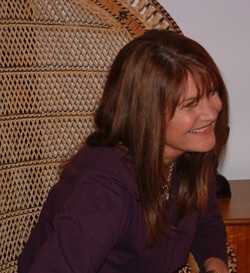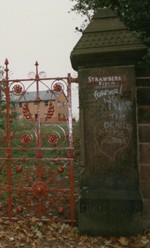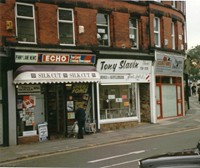60s Music
In the 60s rock'n'roll became pop. Pop music changed with the rest of society. At the beginning of the sixties, it seemed that pop music might become just another form of family entertainment, but by the end of the sixties, it was a way of life.
Before the Beatles
Music at the beginning of the 60s was a sanitised commercial version of mid fifties American rock'n'roll. By then, Billy Haley was out of the picture and Elvis was as much a movie star as a rock'n'roll singer.
In Britain, the melodic sounds of Cliff Richard and Adam Faith competed with the Everly Brothers from the US for the top spot in the music charts. There were young stars like Helen Shapiro, who started her career with four top 3 hits. The favourite dance, the Twist, was enjoyed by the middle aged as well as the young. The rebellious origins of rock'n'roll seemed to be no more than a passing fad. Pop music still played on the juke boxes in the coffee bars of the early 60s. However, many teenagers looked to jazz as a form of rebellion.
Trad Jazz
Jazz music was preferred to pop by many young people in the early sixties. Teenagers hung out in jazz clubs as well as coffee bars. Trad Jazz enjoyed a large following in the early sixties. So much so, that the more commercial practitioners of jazz, such as Mr Acker Bilk, as he was known then, enjoyed considerable chart success. Pop Annual 1964 did a piece on Bilk, and his classic, "Stranger on the Shore", the theme of a TV teatime drama programme of the same name, stayed in the UK charts for over a year.
Beatlemania
In October 1962, four lads from Liverpool, dressed in smart Italian style suits and with mop hairdos, had their first UK hit "Love Me Do"; it reached a modest number 17. A year later, their fourth chart hit "She Loves You" became the best selling single of the sixties in the UK. The Beatles had arrived. Thousands of screaming school girl fans and the rest of the country greeted a phenomenon as yet unknown on these shores.
The Beatles changed everything. They were not officially the first group from Liverpool to have a number one hit though, Gerry and the Pacemakers beat them to it by a month. The Beatles though, were far from just another group. They put pop music in the news and they heralded the British invasion of the US charts.

Swinging London
The Beatles reign at the top, and Liverpool's reign as the centre of British pop music was challenged when a group from London, the Rolling Stones, emerged on the scene. They took their inspiration from rhythm and blues. They appeared scruffy and uncouth; they went out of their way to be as rude as possible. The popular press and the grown-up world hated them; the teenagers loved them. The Stones first UK hit was in July 1963 and their first number 1, "It's All Over Now", in July 64. Their music was uncompromising. They lived for satisfaction and told their story the way it was.
The initial craze for the Merseybeat sound subsided. The Beatles though, changed their style and their sound. They became a part of Swinging London. Together the Beatles and the Stones were the pop scene in the mid sixties.
Female singing stars also attracted much deserved attention. Dusty Springfield complemented her musical prowess and stunning voice with a striking visual image of eye make up and bouffant hair. TV shows helped to keep her and others like Cilla Black, Lulu and Sandy Shaw in the public eye.

Flower Power

Sometime in 1966, the Mods started wearing flowery ties and music was changing. London's fashionable Carnaby Street was satirised in the Kinks' "Dedicated Follower of Fashion". In the following year the Beatles hit "Strawberry Fields Forever" where nothing is real, added to the colourful psychedelic feel. Their "Sergeant Pepper" album, with its mix of psychedelic sounds and Victorian music hall distilled the spirit of the sixties.

In 1967 the focus of the pop world moved from Swinging London to San Francisco, encapsulated in Scott McKenzie's "San Francisco (Be Sure to Wear Some Flowers in Your Hair)". However, arguably, the year belonged to Engelbert Humperdinck, whose old-fashioned style of music ruled the charts, appealing to older age groups with songs such as "The Last Waltz".
The launch of the BBC's Radio One in September 1967, with the aim of replacing the now illegal pirate radio stations, helped bring youthful pop music into the Establishment.
The End
Despite the continued success of the less than 3 minutes pop single, many songs were getting longer some were epics like Richard Harris' "Macarthur Park" whilst some were more stodgy. Soul and dance music, in particular Motown artists, produced vibrant, quality singles that stood the test of time. Diana Ross now began a career without the Supremes she would also promote the upcoming Jackson 5.
The end of the 60s signified the end of an era for pop music and heralded the beginning of a new one. For the Beatles it was "The End". For rock artists like Led Zeppelin, it was the start of a career based on successful albums without releasing singles. Status Quo would swap psychedelia for no nonsense denim clad rock. Artists that did their long apprenticeship in the sixties (Marc Bolan, David Bowie, Elton John, Gary Glitter and David Essex) would spearhead the glam rock phenomenon of the early seventies. The commercial success of reggae broke through with Desmond Dekker's 1969 no 1 "The Israelites" a full six years before Bob Marley entered the singles charts.
Elvis had made his comeback in 1968 with his TV specials and strong emotional songs like "If I Can Dream" followed by "In The Ghetto" and "Suspicious Minds". The Who brought out the "Tommy" album in 1969 and went on to make a successful film of it. The Bee Gees (brothers Barry, Maurice and Robin Gibb) had temporarily and acrimoniously split. They would reform older and wiser, but have to wait some years before returning to the no 1 slot in the UK. Saccharine pop like the Archies' "Sugar Sugar" could still dominate the charts and would continue to do so.
The sixties didn't really go out with a "Boom Bang-A-Bang" but left a legacy of many great songs, artists and records that continue to influence modern day musicians and are still much loved by the public today.
More on sixties music
Teenage life in the 60s
From the Beatles to Hendrix; from short hair to hippy style. This article captures the essence of how teenage life changed in the 60s.
On the Web
My Generation - a site about the sixties music scene today, see www.my-generation.org.uk

